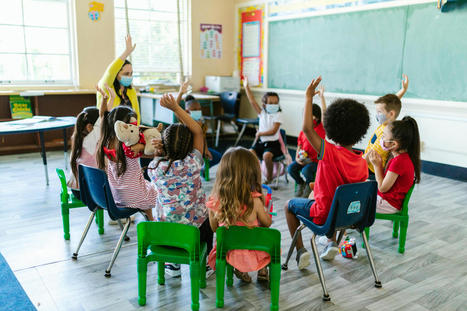 Your new post is loading...
Reading wars or reading reconciliation: A critical examination of robust research evidence, curriculum policy and teachers' practices for Teaching phonics and reading
The primary objective of this research was to investigate the determinants influencing bilingual instruction at the tertiary level in the Chinese educational context. A complex network analysis was adopted for this study. Twenty-one factors were first identified using the Delphi method, a qualitative research method. A complex network was then designed for analysis of the factors. The results indicate that the network is a scale-free network with certain key factors. The findings further reveal that the subject language feature and bilingual instruction models have more connections with other factors, and thus they are the most significant factors to ensure the effective implementation of bilingual instruction. The findings of this research may provide implications for bilingual education.
Transcutaneous vagus nerve stimulation (tVNS) is a promising technique for enhancing cognitive performance and skill acquisition. Yet, its efficacy for enhancing learning rate and long-term retention in an ecologically valid learning environment has not been demonstrated. We conducted two double-blind sham-controlled experiments examining the efficacy of auricular tVNS (taVNS: Experiment (1) and cervical tVNS (tcVNS: Experiment (2), on a 5 day second-language vocabulary acquisition protocol among highly selected career linguists at the US Department of Defense’s premier language school. tcVNS produced accelerated recall performance during training (Day 2–4), benefits of which were maintained across a 24 h retention interval with no stimulation at the final test. Consistent with prior work, tcVNS also produced fatigue-mitigating and focus-promoting effects as measured by the Air Force Research Laboratory Mood Questionnaire. Based on the current and the previous findings supporting tVNS’ efficacy on performance, training enhancement, and fatigue mitigation, we believe tcVNS to be an effective learning acceleration tool that can be utilized at language-teaching and other institutions focused on intensive training of cognitive skills.
Often, schools under-identify multilinguals with dyslexia because they think the issue is language-based, so they don’t evaluate the student. There are places where multilingual students are overrepresented because we think we’ve given them the right kind of intervention when we actually haven’t. So, the relationship between multilingual students and special education is complicated.
/PRNewswire/ -- Amplify, a publisher of next-generation curriculum and assessment programs, today released a first-of-its-kind research brief tha
Babies of bilingual mothers found to respond to wider range of sounds
A look back at Lau v. Nichols, a seminal case for English learner students, and how to continue advancing language rights..
As the nation’s English-learner population continues to grow , researchers look to the Title III for how to best support these students.
Students want to see themselves and their cultures in the books they read in school, and they don’t want token representation.
Scores of AFT leaders and members flocked to New Orleans March 28-30 for the National Association for Bilingual Education’s 53rd International Bilingual Education Conference, where our union ran no fewer than 18 workshops, headlined several featured sessions, offered a full day of parent engagement sessions and celebrated literacy with elementary school book giveaways that included author appearances and readings. The theme for the week: Bilingualism is a superpower.
Worldwide, there are more children who grow up learning multiple languages than children learning only one. And yet monolingualism is often taken as a starting point, for example in school. Research by linguist Elly Koutamanis shows that the two languages of a bilingual child are always active in their brain. "A child can benefit from this bilingual knowledge at school." Koutamanis will receive her Ph.D. on language interaction in bilingual children on 22 March.
According to multiple studies conducted by education experts, dual language learning students take four to seven years to become proficient enough in English.
Modern Languages Studies Professor Dr. Yoichi Mukai is using eye-tracking technology to explore second-language acquisition.Newcomers to Canada often face challenges in developing fluency in the nation’s official languages and attaining these language skills can have impacts on their future.Dr.
|
A new study by researchers from Harvard University, the Massachusetts Institute of Technology (MIT) and Carleton University has found the brain’s language network responds differently to a native language, than additional languages. The study published in academic journal Cerebral Cortex, further explored existing findings on the language center in the brains of people who speak five or more languages, otherwise known as polyglots. Researchers primarily examined what happens in the brains of polyglots when they listen to familiar languages in which they have varying levels of knowledge and proficiency. Using functional magnetic resonance imaging (fMRI) and a group of 34
The University of New Mexico Department of Linguistics recently received a $494,659 National Science Foundation (NSF) grant for their project titled, “Addressee effects in demonstrative systems across bilingual communities.” This three-year project, funded by NSF, will be housed in UNM’s Department of Linguistics and led by Professors Naomi Shin and Rosa Vallejos-Yopán in collaboration with Amalia Skilton from the University of Edinburgh, Scotland.
Darling-Hammond, L., Hyler, M. E., Gardner, M. (2017). Effective Teacher Professional Development. Palo Alto, CA: Learning Policy Institute. https://doi.org/10.54300/122.311. Garcia, A. (2020). Grow Your Own Teachers: A 50-State Scan of Policies and Programs. New America. Retrieved from website: https://d1y8sb8igg2f8e.cloudfront.net/documents/Grow_Your_Own_Teachers_.pdf Giroux, H. A. (1988). Teachers as intellectuals: Toward a critical pedagogy of learning. Greenwood Publishing Group. Hattie, John. (2019). Visible Learning for Teachers. 10.4324/9781003024477. Howard, E. R., Lindholm-Leary, K. J., Rogers, D., Olague, N., Medina, J., Kennedy, B., Sugarman, J., & Christian, D. (2018). Guiding Principles for Dual Language Education (3rd ed.). Washington, DC: Center for Applied Linguistics. Mitchell,C. (2020, February
A new study finds that science and social studies classes may also help young students learn English, even when those classes include difficult and technical vocabulary. The paper is published in the Journal of Educational Psychology.
The language of community Humanities June 6, 2024 - Katy DeCoste Share: Facebook Twitter LinkedIn Email As a student in Mandarin classes at UVic, Mina Guan approached the material as someone who grew up with Mandarin and Cantonese in the home—what’s known as a heritage language learner.
Sara Kangas, associate professor of special education, presents policy brief to special education state agency leaders from across the U.S.
(The Conversation is an independent and nonprofit source of news, analysis an
Learning a new language is perhaps more popular than ever, with the rise of language apps, but is it realistic to learn them quickly? Here are some creative ways to learn language
The nuances of learning to read in more than one language and differentiating service for ELs cannot be left out of the SoR shift.
Bilingual education will only continue to grow, but we need to look at it as a strength to support and develop with the right edtech tools.
How do you help children become fluent in two or more languages, even if you don't speak other languages yourself?
This paper explores the ascent of English as a global lingua franca within the context of linguistic hegemony, following Phillipson’s 1992 framework. It scrutinizes English’s role in the rapidly globalizing world, emphasizing its dominance across economic, governance, and scientific sectors and its impact on non-native English-speaking countries. Utilizing a sociolinguistic approach, combined with historical and interdisciplinary analysis, the study evaluates the influence of English hegemony in cultural, educational, and technological domains, with a focus on post-colonial and expanding circle nations. Additionally, the paper provides critical insights for developing language policies in these areas, considering the intricate role of English in the global linguistic landscape. It concludes by considering the prospects of English language hegemony.
|




 Your new post is loading...
Your new post is loading...



























